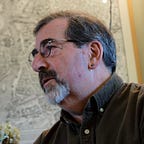City Maps: Ways to View the ‘Polis’
Part 6 in a series on global information design exploring historic maps that represent ways we view the city
2.3 City Maps
Polis is the Greek word for a city-state, a self-governing place, a densely populated urban area. The City Map is a polis diagram. When it is created by or for the ruling group it describes an agreed-upon image of the place. The intention may be to share this view, to boast about or advertise its grandeur and achievements, to identify what the city is and delineate what it is not. When the polis diagram is created by an outsider for a foreign audience, it shows us an exotic place out in the world, a place someone else has traveled to and we hope to reach someday.
The City Map focuses on the center and spreads outward. Its signs of urban civilization dissipate along the edges. The map is a visual confluence of habitation and activity, representing the social, commercial and historical accomplishments of its citizens, whether those citizens are us or them.
To accomplish this, the information designer shapes a message through a combination of point of view and hierarchy of details. How we see the city is as important as what we see or don’t see. The designer invites the viewer to approach — on foot by land, on…
